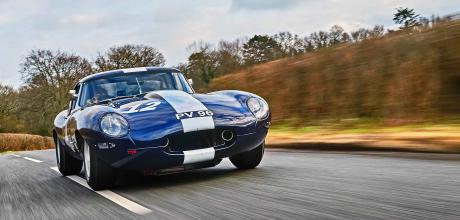1963 Jaguar E-type ‘Semi-Lightweight’
This Semi-Lightweight E-type has shrugged off 60 years of racing scraps and scrapes while retaining unbroken provenance – today we follow Protheroe, Vestey, Mansell and Unser into the driver’s seat.
Words IVAN OSTROFF
Photography GUS GREGORY
Protheroe, Vestey, Mansell, Unser have driven this E-type. And us…
Seminal Survivor
Driving the Jaguar E-type Semi-Lightweight that’s never stopped racing since 1963
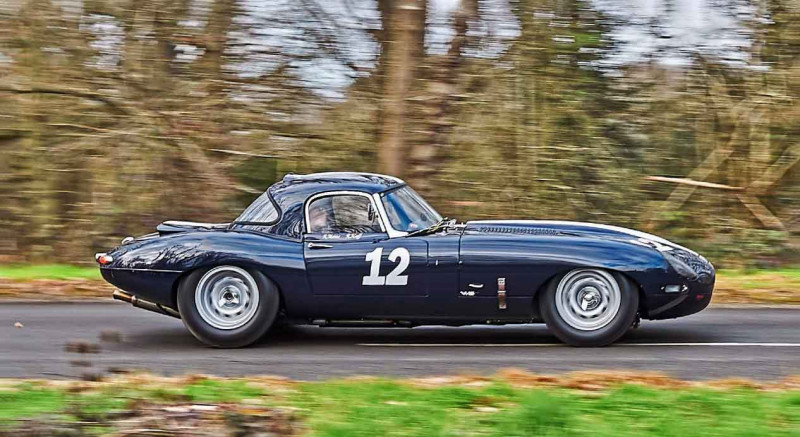
Even as E-types go, this one is pretty sensational. Built from a new bodyshell as a glassfibre-panelled ‘Semi- Lightweight’ FHC racer by its first owner Richard ‘Dick’ Protheroe, today it exists in aluminium-panelled, hardtopped-OTS form – and an utterly stunning one at that, with a smaller ‘mouth’ and headlights than the factory Lightweights. Although not one of the two Jaguar-built Semi’s, this one boasts a continuous provenance and has hosted the likes of Sir Paul Vestey, Bobby Unser and Nigel Mansell behind its small, suede-rimmed wheel. Today I’ll be privileged enough to add my name to that roster.
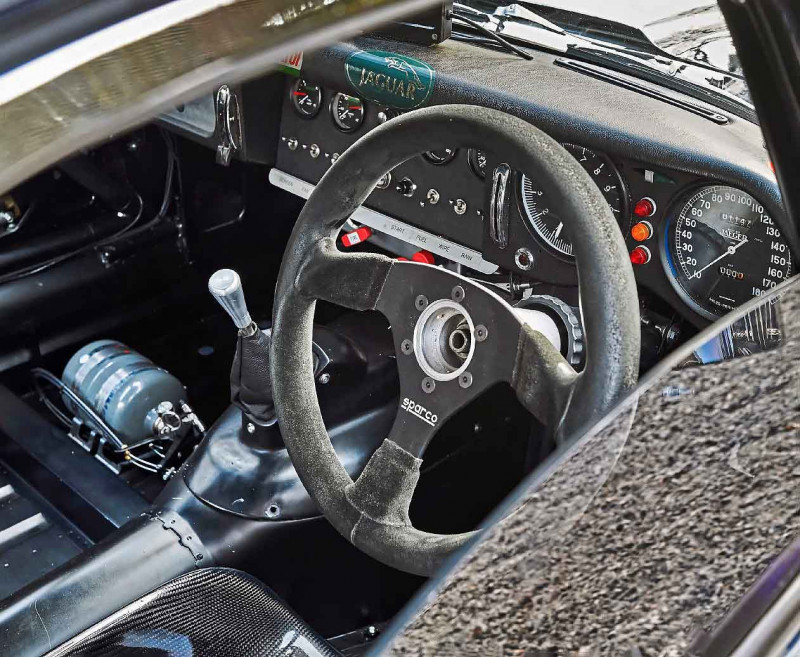
Before contorting myself into the cockpit, I can’t resist unbuckling the leather bonnet straps and tilting the voluptuous prow forward on its hinges to reveal a long, shiny 3.8-litre straight-six fed by three enormous, sand-cast Weber 45DCO3 carburettors – rare and something of an artform in themselves. Early in the car’s life a D-type engine resided here, having been installed into the brand-new bodyshell Jaguar provided to Protheroe. That potent 3.4 is long gone, the casualty of a tough racing career – a running theme with this car. On paper, little if anything remains of Protheroe’s creation, but the clincher is the continuous, unbroken history – and the stories that back it up. More on those later; we have some driving to do.
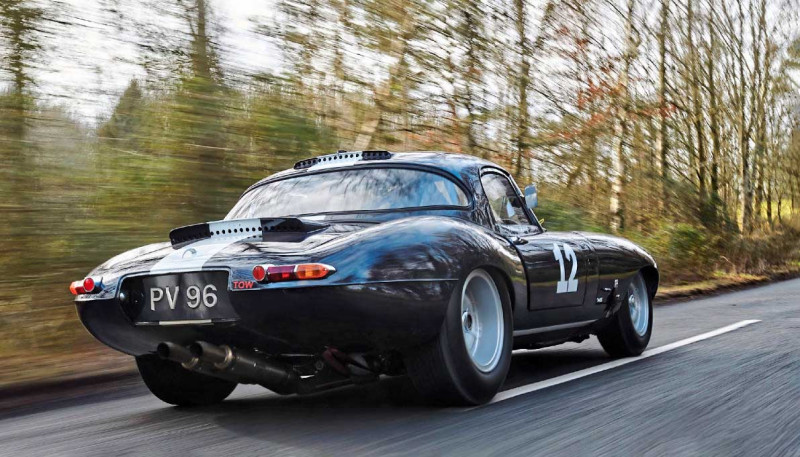
I open the door, carefully negotiate the side protection bar of the roll-over cage, slide my leg down under the wheel and lower myself into the racing seat. There is zerp adjustment, but my feet rest perfectly on the pedals, while my hands rest comfortably just north of the left and right drilled spokes of the E-type’s Sparco wheel. With the full harness clicked into place, to my happy surprise I find the driving position just perfect. The Stack tachometer is rotated, so that 7000rpm appears at the top. For what it’s worth there is a 180mph speedometer to its right; owner Richard Meins tells me that 6500rpm in fourth at Goodwood equates to 148mph, and that’s plenty.
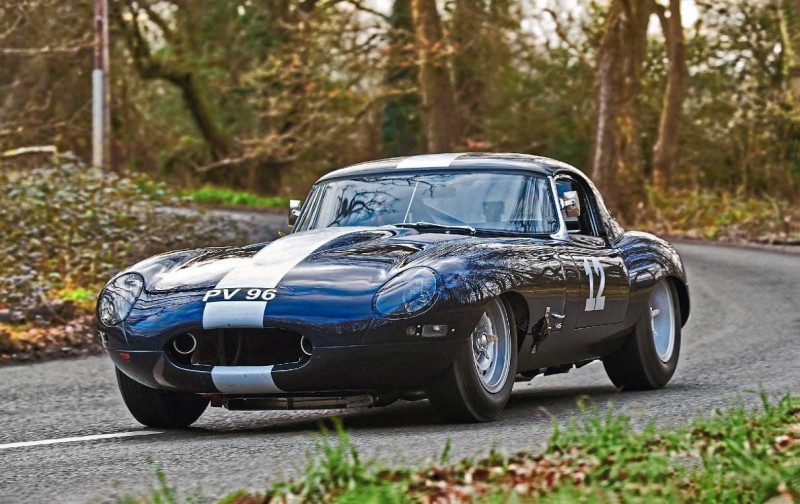
I rotate the battery cut-out to arm the ignition, then twist the key. The Holley fuel pump kicks into life and not being a factory-style submerged unit but situated in front of the rear axle, it’s exceptionally noisy. A further twist, the starter engages and that straight six blasts into life. The raucous din from its twin exhaust pipes destroys the serenity of the Sussex countryside instantly. While the dohc masterpiece settles itself and ticks over relatively smoothly at 800rpm as it warms through, Richard warns me that grip will be atrocious in the wet on cold tyres, so when I do get going I climb up through the gears tentatively. The racing clutch is heavy but as I slip in and out of the gears, the change feels snicky and fast, even before optimum temperature is reached. The engine is torquey and pulls from well below 2000rpm in all the gears. Without a helmet or ear protection, the exhaust is a deep, resonant boom and unless you are in top the gearbox whines relentlessly, never allowing you to forget this car’s primary purpose. There’s no let-up from that fuel pump either.
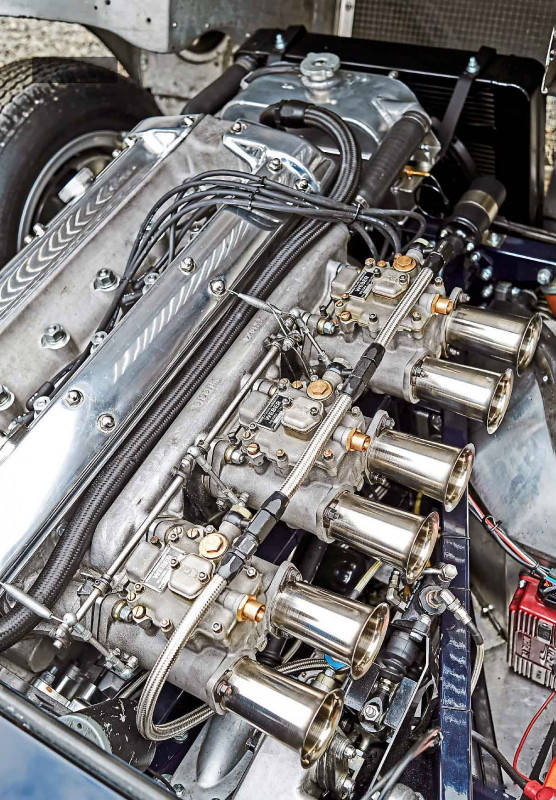
Now having a feel for the car I floor the throttle and watch the tacho needle twist past 4000rpm while the exhaust bellows and that straight six howls with abundant power. Richard told me he changes up at 6200rpm. I don’t wait for that, and snick the lever back before 6000 just to be safe. The engine is a full lightweight spec – aluminium block, wide-angle cylinder head and on sandcast Weber 45DCO3s, worth an extra 30-40lb ft of torque.

On the move the steering is easy enough but not overly light. Small wheel, quick rack, I can feel what those 6LX15 Dunlops feel. A little bit of feeding in, then a squeeze of the throttle; grip is retained and my heart heads back to my chest after a brief visit to my mouth. I pitch the car into a fast bend; the E-type is responsive, but on the damp slippery surface the first reaction to my steering input comes from the back end. I trail the throttle and correct the back end slide, trying to prevent these dampslithery country lanes letting the Jaguar become over-skewed. As the car responds to my right foot, I centre the helm and squeeze the accelerator cautiously as I exit the corner.
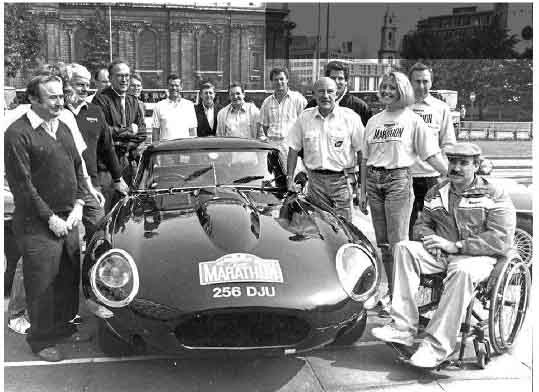
The roads are drying out now, the rubber is warming and grip has arrived. Easing off an oversize application of opposite lock, I straighten the wheel and this time, I plant my foot hard onto the accelerator and hold it there. The rear tyres bite and PV96 launches itself straight forward as if it’s trying to outpace time. At the end of a long straight I brake hard and double declutch down into second, the exhaust crackling and banging on the over-run. Under braking the nose barely dips, the Jaguar now boasting a stiff race-oriented suspension setup consisting of Koni oil-filled two-way adjustable dampers, competition specification torsion bars and a massive anti-roll bar. I cannot fault the braking power of PV96 under road conditions – it now sports larger rear discs and calipers from a Mk10 saloon – and I experience no noticeable fade.
The recent upgrades are the latest chapter in a story that began 60 years ago when celebrated Jaguar exponent Protheroe was racing his E-type Special Coupé, chassis DP138D5. He’d built it up from a bodyshell provided by Jaguar and registered it on 22 March 1963, with the registration ‘CUT7’. At the Spring 1963 race meeting at Snetterton the car was pranged but Protheroe had it back together by Easter and finished fourth in the Sussex Trophy at Goodwood, and third in May at Silverstone. Following Protheroe’s purchase of the Low-Drag E-type coupé, he transferred the number CUT7 to that vehicle and re-registered chassis DP138D5 as 256DJU. Some time later, he sold 256DJU to Roger Mac who raced it extensively.
Enter fourth owner Sir Paul Vestey, ‘I bought 256DJU in 1965 from David Cunningham who I believe bought it from Roger Mac. At that stage it was a fixed head, with the rear door removed and a plastic window, which filled in the whole of the rear. I bought it because I knew that it had been built up and prepared by Protheroe, who was pretty good with Jaguars in those days. It had a Jaguar D-type wide-angle engine but not a D-type gearbox; I think it had an XK120 unit. It also had Dunlop alloy wheels, which Cunningham had put on at vast expense. It was a great car, very quick everywhere.
‘The first race that I did in it was at Snetterton; all was going well, I was in the lead and then, after about eight laps, the thing threw a rod and made a big hole in the sump which was rather disappointing. D-type engine spares were pretty difficult to find back then so we replaced it with another hot engine, probably from an XK150. It was alright but the demise of the D-type engine was regrettable, because it was certainly considerably more powerful. Also, having a dry sump, it was a little bit lower and so it really was better as it had a lower centre of gravity.
‘Then at Goodwood, I crashed on the second lap in a moment of madness. I don’t quite know why, but coming out of the chicane, I was going to overtake another E-type when we touched. He ended up on one side of the road and I ended up on the other, with the bonnet up and flying off.
‘I continued running it for some time and we won several races including a TT at Mallory Park. Then the chap I was sharing it with, Richard Ward, had an accident at Silverstone during testing that pretty much destroyed the bodyshell. We had good connections with Jaguar though, and I got them to provide us with a new roadster ‘shell. The old crashed FHC ’shell was in fact delivered to the scrap yard, but that’s another story!
‘We then transferred everything from the damaged coupé and built it up with all our running gear, engine, suspension, everything put into it. We fitted a lightweight glassfibre bonnet and various other bits, including the hardtop, and then carried on racing it. I’m not sure what was left of the original Protheroe car by that point but we raced it until about halfway through 1966. Goodwood, Oulton Park, Mallory Park, Crystal Palace, Brands Hatch, Snetterton; we never took it abroad, but did just about all of the British Circuits of those days. Then, I wanted to race more internationally so I bought the ex-Maranello Concessionaire’s 1966 Ferrari 275GTB/C Le Mans car and sold 256DJU to John Lewis in November 1966 for about £1600.’
John Lewis then took 29 wins and six lap records, which included 17 wins on the trot. John says, ‘That car was very good to me. We won at every circuit in the country except Lydden Hill, which I never went to, and Cadwell Park, which had a 2.0-litre limit at that time. I remember that the brakes often wouldn’t last. At Oulton Park, I had been under the lap record in the morning and I tried a tad too hard. After about three laps, the brakes disappeared so I was pumping the pedal with my left foot hoping that I would have brakes again by the next corner. My left leg became completely numb! I think it was around the end of 1968 when I sold it to a chap called Robin Darlington.’
The car passed through three more owners before John Lewis saw it advertised in 1979, and bought it back. John recalls, ‘It had been converted into a road car but I recognised it and bought it for £6000. Fortuitously the intervening owners had kept all the competition equipment and gave me everything without exception. So I put it back together as a racer once again, but this time with aluminium panels instead of glassfibre. Then I put a neighbour of mine into the car; he was an up-and-coming lad, currently racing Formula Ford. Nigel Mansell. He raced it half a dozen times and apart from stuffing it at Silverstone when the throttle stuck at Copse during practice, he was very successful.’ ‘Then in around 1982, I contacted Roger Mac, we were both in our forties and got on well. Although he’d retired from racing when he was 21, I invited him to Oulton Park to try his old car, which resulted in him driving it for the next few years. We obtained sponsorship from Jaguar too, and Roger won every round of the FIA European Historic Championship in 1983 and 1985. We also won the 1987 title outright.’
In June 1990, 256DJU was entered for the Pirelli Classic Marathon, piloted by four-times Indy 500 winner Bobby Unser. Having incurred a two-minute time penalty for some crazy driving over the Stelvio Pass, Unser then hit a bus head-on while trying to navigate a small village. His co-driver Dave Killian needed stitches in his forehead and the E-type required significant work to straighten its lightweight aluminium bonnet. Thereafter, John campaigned the car himself, his efforts including a fourth place finish on the Tour de France. ‘We were actually second on the road but were penalised for a coffee stop,’ he recalls. ‘In November 2016, exactly 50 years to the month after I’d bought it from Vestey, I sold 256DJU to Richard Meins.’
Richard initially planned to drive it on the road, but since it was still largely as it was when it was racing in the Nineties, he soon realised it was far better suited to the track and sent it to Tom Adams at Valley Motor Sport. Says Tom, ‘The bonnet, boot and doors are the aluminium panels fitted by John Lewis; there are even some original pen markings on the inside of the bootlid. We repaired some panel rot and fitted a new front frame with strengthened engine mounts and a new rollcage. The D-type engine [a second, fitted by John Lewis] was removed and replaced with a correct 3.8 litre E-type engine for Goodwood. Sir Paul Vestey perhaps summarises the car best. ‘On a car that goes out racing, things break and bend and therefore, things are replaced. If a car is rebuilt several times, well then it probably does not bear much relation to the car that left the factory. But it’s still the development of that original car. Some folk get very puritanical, but that’s racing cars for you, isn’t it? I’m not sure if there is anything left of the original Protheroe car that I bought, but obviously the important thing is a continuous history and not one that is suddenly invented. This car certainly has that from the day I bought it until now.’
It may have been continually repaired and redeveloped through its life, but this storied machine still retains Protheroe’s spirit, both in lineage and character.
TECHNICAL DATA 1963 Jaguar E-type ‘Semi-Lightweight’
- Engine 3781cc straight-six, dohc, three Weber Weber 45DCO3 carburettors
- Max Power 385bhp @ 6100rpm
- Max Torque 366lb ft @ 5100rpm
- Transmission Jaguar four-speed manual, rear-wheel drive
- Steering Rack and pinion
- Suspension Front: independent wishbone and torsion bar, Koni oil-filled two-way adjustable dampers, anti roll bar. Rear: independent wishbone, radius arms, coil springs, Koni oil-filled two-way adjustable dampers
- Brakes Dunlop discs all round
- Weight 1000kg
- Performance Top speed: 150mph approx
- Acceleration 0-60mph: 4.5sec approx
- Cost new Not known
- Value now £750,000 approx
60 years on, and still adding fast-paced chapters to its story. Sand-cast Weber 45DCO3s are the XK engine’s crowning jewels.7in-wide rear tyres fill out the E-type’s voluptuous hips.Grippy wheel helps driver keep lively tail in check Today an OTS, and back painted in Vestey’s liver.
Suede wheel a later addition. ‘I still have the original,’ says Vestey Venting for cabin heat Bonnet gills cool the ’six Simple, light Solutions.
‘It was good to me. We won at every circuit in the country except Lydden Hill and Cadwell Park’
Owning a Semi-Lightweight E-type
‘I race lots of cars, including Group C prototypes,’ says Richard Meins. ‘PV96 is rather challenging to get the best out of, but it’s great to drive; the torque at low revs is terrific and it’s unbelievably fast. Through the corners on a track you are drifting everywhere and never in a straight line. It will even spin its rear wheels in third gear under certain conditions. We tried setting it up with some oversteer but it proved a real handful. It is now pretty pointy but you are constantly sawing on corrections to maintain that straight line. ‘A Cobra will be a little quicker in a straight line but the E-type is better handling so will catch up on the corners because the grunt can be put down in different places. Last year I shared the car with Rob Huff at Goodwood and we came third in the Tourist Trophy.’
Keen eyes will spot Roger Clark, Bobby Unser, Paddy Hopkirk, Stirling Moss, Alec Pool and Clay Regazoni.


